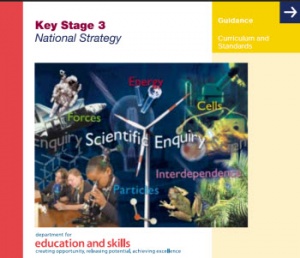Modeling Scientific Writing: Difference between revisions
SimonKnight (talk | contribs) No edit summary |
m (subjects, ages, types) |
||
| Line 1: | Line 1: | ||
{{Rinfo | {{Rinfo | ||
|type= Teacher Education | |||
|title= Modelling Scientific Writing | |title= Modelling Scientific Writing | ||
|topic= Modelling | |topic= Modelling | ||
|final=yes | |final=yes | ||
|image=Climateforgrouptalk-dfes1.jpg | |image=Climateforgrouptalk-dfes1.jpg | ||
|subject= Science, Teacher Education | |subject= Science, Teacher Education | ||
|resourcenumber=TE0066 | |resourcenumber=TE0066 | ||
|age= Secondary | |age= Higher, Secondary | ||
|tagline=How do we help pupils to express themselves adequately when they write? | |tagline=How do we help pupils to express themselves adequately when they write? | ||
|content=Modelling text - showing pupils how to select and manipulate content - is a proven strategy to improve the outcome of writing tasks. It helps pupils to avoid common errors and substantially reduces marking. Because they have a good model in their heads of what they need to produce, it raises pupils’ confidence in their ability to undertake a task. | |content=Modelling text - showing pupils how to select and manipulate content - is a proven strategy to improve the outcome of writing tasks. It helps pupils to avoid common errors and substantially reduces marking. Because they have a good model in their heads of what they need to produce, it raises pupils’ confidence in their ability to undertake a task. | ||
Latest revision as of 15:33, 28 September 2012
About. Modelling text - showing pupils how to select and manipulate content - is a proven strategy to improve the outcome of writing tasks. It helps pupils to avoid common errors and substantially reduces marking. Because they have a good model in their heads of what they need to produce, it raises pupils’ confidence in their ability to undertake a task. The 6 page resource, from a larger DfES document contains examples of the types of writing pupils might encounter in science, and shows their relationship to writing styles.
Pedagogical content. This resource discusses methods for modelling(ta) scientific writing, and the structure and kinds of language(ta) used in such writing. It provides exemplars and suggests activities to assist teachers to apply these methods to their own practice. (edit)
| Resource details | |
| Title | Modelling Scientific Writing |
| Topic | [[Topics/Modelling|Modelling]] |
| Teaching approach | [[Teaching Approaches/Language|Language]], [[Teaching Approaches/Modelling|Modelling]] |
| Learning Objectives |
|
| Subject | [[Resources/Teacher Education|Teacher Education]], [[Resources/Science|Science]] |
| Age of students / grade | [[Resources/Secondary|Secondary]], [[Resources/Higher|Higher]]
|
| Files and resources to view and download | Word file taken from a larger document File:Modeling Scientific Writing.doc also available in WikiText format See other DfEScience(i) resources
|

